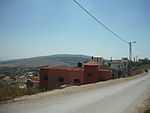Tamra, Jezreel Valley
| Tamra | |
|---|---|
 | |
 Tamra | |
| Coordinates: 32°38′5″N 35°24′8″E / 32.63472°N 35.40222°ECoordinates: 32°38′5″N 35°24′8″E / 32.63472°N 35.40222°E | |
| Council | Gilboa Regional Council |
| Population (2006) | 1,300 |
| Name meaning | from to make a pit for storing corn & c.[1] |
Tamra (Arabic: طمرة; Hebrew: טַמְרָה or תַמְרָה) is an Arab village in north-eastern Israel. Located in the Jezreel Valley, it falls under the jurisdiction of Gilboa Regional Council. In 2007 it had a population of 1,300.[citation needed]
History
When the French explorer Victor Guérin visited Tamra, he noted: "This village has taken the place of an ancient town which formerly rose in an amphitheatre around an abundant spring, whose waters are received in a regular basin formerly vaulted. Everywhere considerable piles of stones, for the most part basaltic; the remains of overthrown houses strew the slopes of the hill. In the midst of these confused ruins I remarked, near the spring, the vestiges of a small church lying east and west and divided into three naves. It was ornamented with columns, of which several trunks yet remain. In the higher part of the city are still distinguished the remains of a second church, almost entirely destroyed, which was paved with mosaic, as is proven by the little cubes lying about on the ground."[2]
A village was here in the Byzantine period; tombs and remnants of two churches have been found.[3]
Under the name Thamra, it was mentioned as part of the domain of the Crusaders during the hudna between the Crusaders based in Acre and the Mamluk sultan al-Mansur (Qalawun) declared in 1283.[4]
In the late nineteenth century, the Palestine Exploration Fund's Survey of Western Palestine (SWP) described Tumrah as "a village of middling size, perhaps 50 or 70 houses, situated on high ground, and surrounded by plough-land." They also noted that there were ruins on the south side of the village.[5]
At the time of the 1931 census, Tamra had 34 occupied houses and a population of 193 Muslims.[6]
See also
References
- ↑ Palmer, 1881, p. 170, see p. 117
- ↑ Guérin, 1880, p. 124-125, as translated by Conder and Kitchener, 1882, p. 130
- ↑ Yoram Tsafrir, Leah Di Segni and Judith Green (1994). Tabula Imperii Romani: Judaea, Palaestina. Jerusalem: Israel Academy of Sciences and Humanities. p. 239.
- ↑ Dan Barag (1979). "A new source concerning the ultimate borders of the Latin Kingdom of Jerusalem". Israel Exploration Journal 29. pp. 197–217.
- ↑ Conder and Kitchener, 1882 p.87- 88
- ↑ E. Mills, ed. (1932). Census of Palestine 1931. Population of Villages, Towns and Administrative Areas. Jerusalem: Government of Palestine. p. 76.
Bibliography
| Wikimedia Commons has media related to Tamra, Jezreel Valley. |
- Abu Fana, Mohammed (30/12/2009): Tamra Final Report, Hadashot Arkheologiyot, no.121
- Alexandre, Yardenna (23/8/2009): Tamra Final Report, Hadashot Arkheologiyot, no.121
- Conder, Claude Reignier; Kitchener, H. H. (1882). The Survey of Western Palestine: Memoirs of the Topography, Orography, Hydrography, and Archaeology 2. London: Committee of the Palestine Exploration Fund.
- Dauphin, Claudine (1998). La Palestine byzantine, Peuplement et Populations, Vol. III : Catalogue. BAR International Series 726. Oxford: Archeopress. (p. 734)
- Guérin, Victor (1880). Description Géographique Historique et Archéologique de la Palestine. Vol 3; Galilee, pt. 1.
- Hadawi, Sami (1970), Village Statistics of 1945: A Classification of Land and Area ownership in Palestine, Palestine Liberation Organization Research Center p.63
- Hütteroth, Wolf-Dieter; Abdulfattah, Kamal (1977). Historical Geography of Palestine, Transjordan and Southern Syria in the Late 16th Century. Erlanger Geographische Arbeiten, Sonderband 5. Erlangen, Germany: Vorstand der Fränkischen Geographischen Gesellschaft.
- Mills, E., ed. (1932). Census of Palestine 1931. Population of Villages, Towns and Administrative Areas. Jerusalem: Government of Palestine.
- Palmer, E. H. (1881). The Survey of Western Palestine: Arabic and English Name Lists Collected During the Survey by Lieutenants Conder and Kitchener, R. E. Transliterated and Explained by E.H. Palmer. Committee of the Palestine Exploration Fund.
- Porat, Leea (13/4/2005): Tamra, Hadashot Arkheologiyot, no.117
- Porat, Leea (16/12/2007): Tamra, Hadashot Arkheologiyot, no.119
- Tepper, Yotam (16/8/2007): Tamra Final Report, Hadashot Arkheologiyot, no.119
External links
| ||||||||||||||